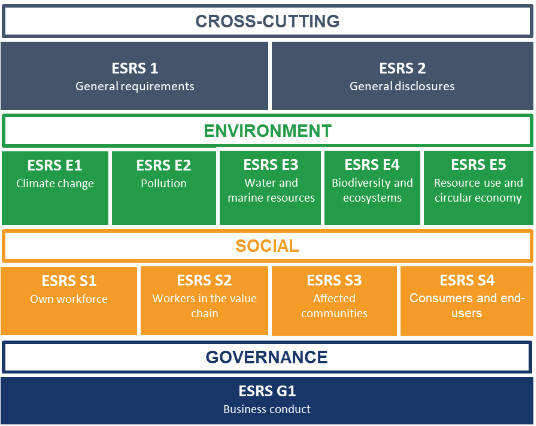CSRD in practice: working with the ESRS datapoints

CSRD in practice: working with the ESRS datapoints
The European Sustainability Reporting Standards (ESRS) accompanying the Corporate Sustainability Reporting Directive (CSRD) consists of 245 pages, two general and ten topical reporting standards and 1231 datapoints. How are you supposed to actually work with all this information and these requirements in practice? In this blog, we will dive into the ESRS datapoints, aiming to identify trends and general conclusions to simplify working with the CSRD and present our own solution to tackle this amount of datapoints.
Topical standards within the CSRD
The aforementioned topical standards are built around the three pillars of ESG: environment, social and governance. The ESRS standards are visualized below.

What topics are ultimately to be reported on, depends on the double materiality assessment, about which you can read more in this and this blog, or contact us for our double materiality service.
Trends and findings on ESRS datapoints
To guide companies in preparing their sustainability statements, the European Financial Reporting Advisory Group (EFRAG) – the agency in charge of the ESRS development – issued a detailed file containing the list of datapoints that are distilled from the various ESRS standards.
With a first look on the list of datapoints, you could easily become overwhelmed. Rows of disclosure information seem to continue endlessly. Luckily some structure can be identified:
- Every reporting standard consists of multiple disclosures, separated by thick lines. An example is ESRS E1 Climate Change, which is subsequently divided into 12 disclosures such as transition plan for climate change mitigation and energy consumption and mix.
- A translation of the ESRS text to the requested information is identified by paragraph numbers corresponding to the ESRS text paragraphs.
- For every datapoint reference is made to the related application requirements (ARs) to guide proper presentation.
- The type of datapoint is presented by using terms as ‘narrative’, ‘semi-narrative’ and ‘monetary’, i.e. ‘unlimited amount of text’, ‘limited choice options with a drop-down menu’ and ‘monetary value’. Voluntary datapoints are coloured orange.

However, also some more in-depth remarks can be made about the list of datapoints:
- Several requirement descriptions are indicated as individual datapoints, while in earlier versions this did not seem to be the case. Requirement descriptions can be recognized by their bold paragraph font in the ESRS text. An example includes ESRS 2 BP-2 Paragraph 6:

Presumably, also other circumstances than those already mentioned in the remainder of the disclosure, such as time horizons, value chain estimations and outcome uncertainty, are to be reported on.
- Application requirements are not only of guiding nature, but on numerous occasions also serve as an individual datapoint, thus requiring in-depth information in the sustainability statements. To know which AR belongs to which ESRS paragraph, you can easily consult the list of datapoints, as it is listed directly under the relevant passages.
- The minimum disclosure requirements (MDRs) were previously seen as overarching general requirements, but are actually interlinked with the topical standards. This is due to their explicit references in sections mentioning policies, actions, targets and metrics. These references include disclosure of reasons why no policies or actions have been adopted yet and timeframes in which those will be in place.

2Impact CSRD tool
We understand that all this can still feel overwhelming to you. That is why 2Impact provides guidance on how to tackle this amount of datapoints. While the datapoint list is useful in performing a gap analysis, it should be read in combination with the ESRS. In our developed CSRD tool, these two elements are combined to help you perform a gap analysis yourself.
The tool is designed keeping the ESRS structure in mind: disclosure requirements and the accompanying requested information are grouped and the number and type of EFRAG datapoints is projected. In one glance it becomes clear whether a disclosure is mandatory, voluntary or phased-in. A summary of your performance is presented in the dashboard, which shows the type of disclosure gap (e.g. ‘target’ or ‘action’) and effort required to comply with the CSRD, both overall and per ESRS standard. Using our tool brings comfort and efficiency in times of feeling overwhelmed. With the ongoing datapoint updates, we keep on improving our tool and our latest version is now ready for you.
Don’t want to do the gap analysis yourself? We are happy to do it for you. Please reach out to esther@2impact.nl and let us know what we can do for you.
Sustainability newsletter
Would you like to stay up to date on the latest developments in sustainability reporting? Subscribe to our newsletter here.

